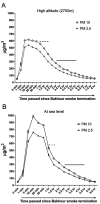Studying the effect of particulate matter as SARS-CoV-2 transmitters
- PMID: 34674518
- PMCID: PMC8883553
- DOI: 10.4081/jphr.2021.2521
Studying the effect of particulate matter as SARS-CoV-2 transmitters
Abstract
Background: Studies of risk factors are especially valuable at this difficult time in the midst of a pandemic. High levels of particulate matter (PM) represent a serious risk factor on health. While this is a direct impact on health, indirect effects are worth considering, too.
Design and methods: The aim of this study was to investigate the role of PM in the transmission of viruses, especially SARS-CoV-2. Also, we sought to understand dynamics of PM in still air at high and low altitudes. Historic AQI and physical PM measurements were collected between August and September 2020 using air quality detector. Potential correlations between the number of total confirmed COVID-19 cases and average air quality index (AQI) from varied geographic locations were also assessed.
Results: Airborne PM levels were weakly associated with COVID-19 cases after analysing 77 territories. PM remained longer in the air at high altitudes compared to measurements made at sea level. This suggests that the link between PM and COVID-19 transmission could be aggravated in areas of high altitude.
Conclusions: This article highlights that particulate matter can be involved in SARS-CoV-2 transmission. However, confounding factors may have impacted the association between the two variables. These findings can serve as a foundation for future studies on the effect of air pollutants and fine particulate matter on viral transmission.
Figures



Similar articles
-
Assessing the relationship between surface levels of PM2.5 and PM10 particulate matter impact on COVID-19 in Milan, Italy.Sci Total Environ. 2020 Oct 10;738:139825. doi: 10.1016/j.scitotenv.2020.139825. Epub 2020 Jun 2. Sci Total Environ. 2020. PMID: 32512362 Free PMC article.
-
Sandstorm and its effect on particulate matter PM 2.5, carbon monoxide, nitrogen dioxide, ozone pollutants and SARS-CoV-2 cases and deaths.Sci Total Environ. 2021 Nov 15;795:148764. doi: 10.1016/j.scitotenv.2021.148764. Epub 2021 Jun 30. Sci Total Environ. 2021. PMID: 34252765
-
Exposure to particulate matter: Direct and indirect role in the COVID-19 pandemic.Environ Res. 2022 Apr 15;206:112261. doi: 10.1016/j.envres.2021.112261. Epub 2021 Oct 20. Environ Res. 2022. PMID: 34687752 Free PMC article.
-
Air pollution particulate matter as a potential carrier of SARS-CoV-2 to the nervous system and/or neurological symptom enhancer: arguments in favor.Environ Sci Pollut Res Int. 2021 Aug;28(30):40371-40377. doi: 10.1007/s11356-020-11183-3. Epub 2020 Oct 13. Environ Sci Pollut Res Int. 2021. PMID: 33051841 Free PMC article. Review.
-
Air pollution and COVID-19: Is the connect worth its weight?Indian J Public Health. 2020 Jun;64(Supplement):S132-S134. doi: 10.4103/ijph.IJPH_466_20. Indian J Public Health. 2020. PMID: 32496243 Review.
Cited by
-
Influence of Environmental Factors and Genome Diversity on Cumulative COVID-19 Cases in the Highland Region of China: Comparative Correlational Study.Interact J Med Res. 2024 Mar 25;13:e43585. doi: 10.2196/43585. Interact J Med Res. 2024. PMID: 38526532 Free PMC article.
References
LinkOut - more resources
Full Text Sources
Miscellaneous

